Persian Palms
109-111 Washington Ave. So.
Minneapolis
The Persian Palms Nite Club was located at 109-111 Washington Ave. So., deep into Skid Row.
THE BUILDING
Minneapolis permit records don’t show when the building was built, but it was there as of 1891. It was a hotel with a store on the ground floor at that time. By 1898 the ground floor was a saloon, and in 1905 there was also a pawn shop on the premises. During Prohibition there are notes for a cafe, barber shop, and pool room; it continues to say cafe until June 1936 when it changes to “beer parlor.”
Much of the information for this page comes from an article in the Minneapolis Tribune written by Charles Hanna on August 27, 1961, just before the Persian Palms was to meet the wrecking ball. I will annotate these passages as “Hanna.”
The bar was also rife with “B-Girls” who implored customers to buy them drinks.
It may have been the most popular of the many, many bars in the Skid Row sector, no doubt because of its entertainment.
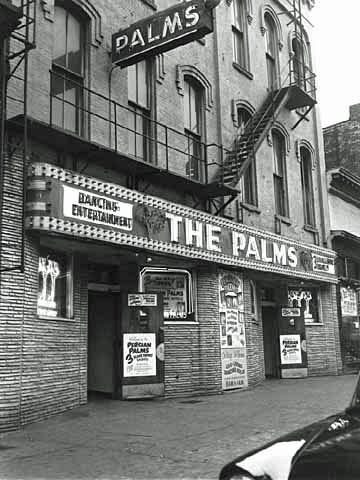
DESCRIPTION
Hanna provides these insights into what the Persian Palms looked and felt like:
The sign featured red, yellow, and green bulbs.
Bar stools stood at the two bars in the club’s front room, where exotic dancers sat with their short skirts hoisted above their knees.
There was a big tin sign that hung over the rear of the building that read “Welcome to the Persian Palms … Live Music and Entertainment.” A painted palm tree on the sign shaded a dancing couple dressed in a tuxedo and evening gown, uncommon attire in the club even in its heyday.
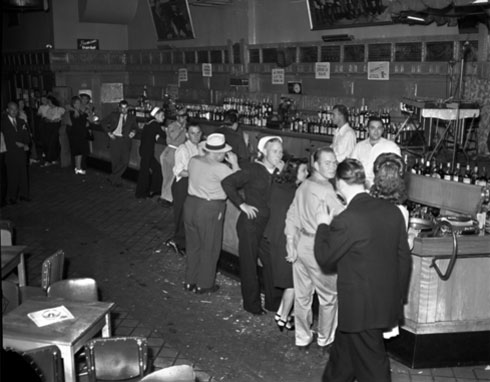
Visitor magazine provided this description of the wonders of the club in 1960:
The biggest bevy of beautiful girls in town, providing voluptuous and exotic type entertainment. The Palms always provide a lot of easy on the eyes, but hard on the heart performances. Beautiful dolls, gorgeous gals, Western music and song all day long. The most talked of spot in the Twin Cities. Ten gorgeous cuties make this the Lido of Minneapolis. Minneapolis’ answer to a Parisian Holiday. Why go to Paris when that certain famous something Paris offers is right here in town. Enjoy the best drinks during the best show anywhere. Not a penny extra for a million dollar production. No cover or minimum.
BEER TAVERN
In January 1936, Mrs. Jule Sund Kadrie had a 3.2 beer license at the Persian Palms, and applied for a liquor license. The City Council took the request under advisement because her husband had been arrested twice for gambling. Her request was denied. In March 1936 she applied for a dance hall license, which was approved in April 1936.
On April 1, 1936, Mrs. Kadrie was charged with allowing a 17-year-old to dance in the beer parlor. She was acquitted.
On January 7, 1939, Mrs. Kadrie was arrested in a police sweep of bars looking for gambling equipment. She was found with two 14 boards, a spin-O game, and a dice game called Bing. Citing the Bing game as “particularly treacherous,” the judge fined Mr. Kadrie $100 for keeping a gambling house. (Minneapolis Star, January 20, 1939)
Gambling again was the charge when Mrs. Kadrie was summoned to court on January 9, 1940. The judge acknowledged that he had heard so much about the place that he was bound to be prejudiced, so he continued the case until his term ended. His successor assessed the fine of $75. (Minneapolis Star, February 10, 1940)
Riots, stabbings, thefts, and other mayhem were reported at the tavern.
Mrs. Kadrie’s 3.2 beer license was revoked on April 1, 1940.
HARRY SMULL
The bar was back in business by January 1941, as we learn in a report of a stabbing, natch. At about the same time, the bar obtained a liquor license, transferred from 312 S. Fourth Street. (Hanna) It is unclear who was operating the bar or who owned the liquor license.
It was only in October 1942 that the bar’s ownership was listed in the paper as the Minnesota Tavern Corp., Harry Smull, President. Smull, at various times, owned several other bars, including the Little Dandy, Old Bowery, Bowery, Frolics, and the Saddle Bar.
On December 29, 1942, fire routed 55 customers and destroyed the bar. Repairs were made in February and March 1943.
ENTERTAINMENT
Ads for shows only started in earnest in 1948. Below is just a sample to get a taste of the entertainment that could be had at the Persian Palms.
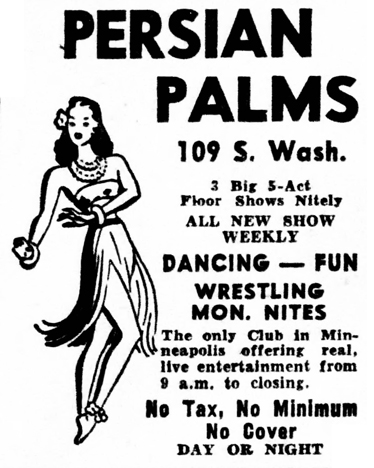
THE BEEF TRUST CHORUS
How about an act featuring five ladies each over 300 pounds? The concept goes back to the turn of the century.
And there were lots of shows featuring female impersonators – in 1949!? Dressing in drag for a show was okay, but if you were caught in a dress in a gay bar you were hauled off to jail.
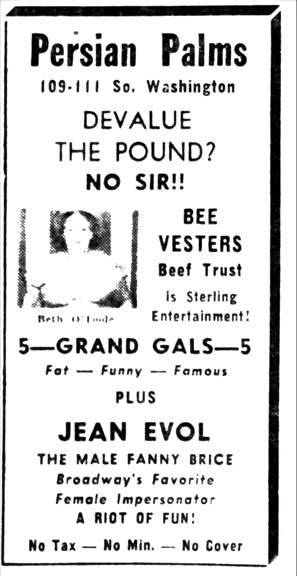
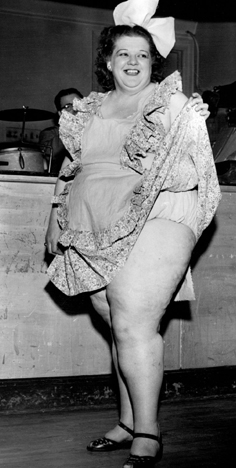
DIVINA IN A TANK
And there was Divina, the underwater stripper. The ad is hard to read; it says,
Curves alive with the poetry of artistic and unrestrained motion … sheer lovliness in bodily rhythm … AN EYEPOPPING SUBMARINE DISPLAY OF SINUOUS, ARTISTIC ACTION Underwater, on stage, in person.
Note the two uses of the word “artistic.”
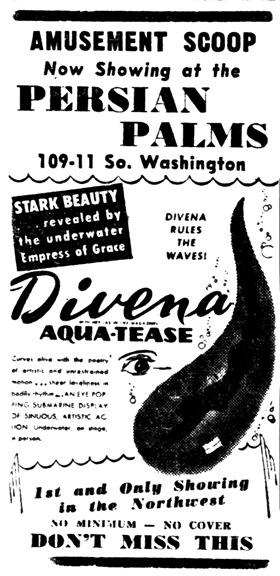
Around that time, the famous New York photographer known as Weegee was in town and took the photo below of a man in front of the Palms. Devina is being advertised in the window.
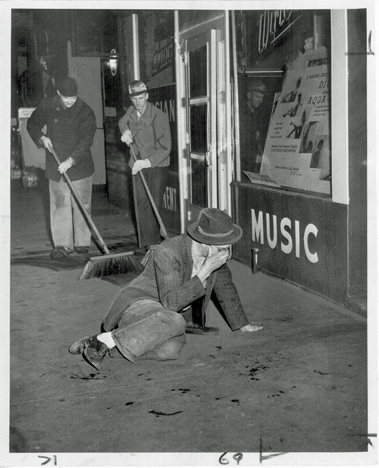
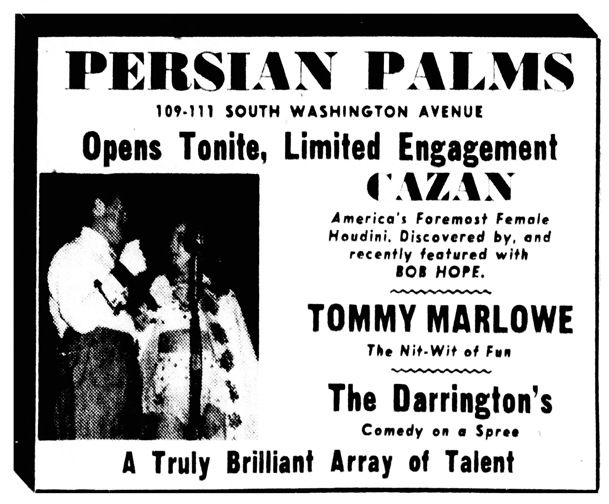
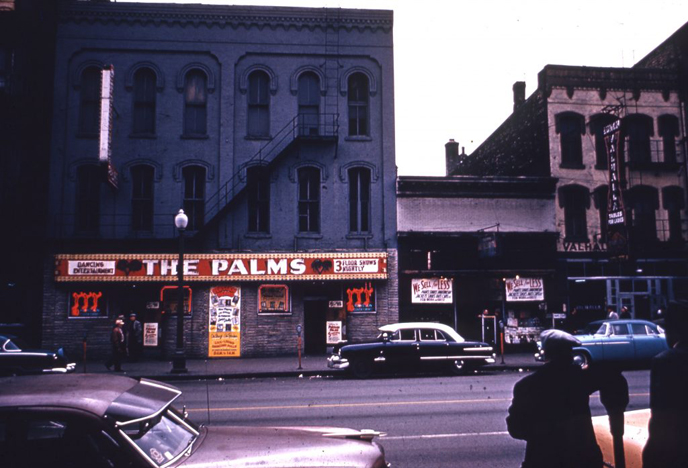
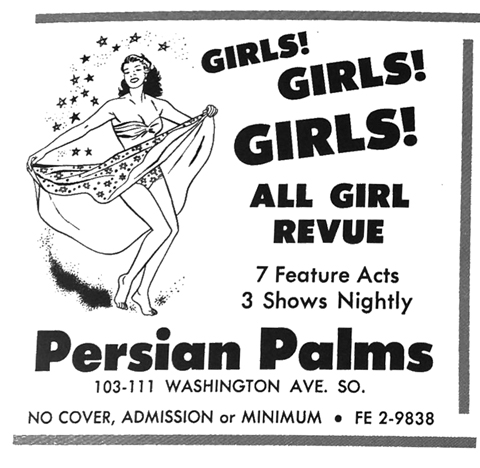
THE MURDER OF BARBARA JEAN LACOUNT
Jeff Neuberger tells this tale of murder of a stripper/B-Girl at the Persian Palms:
On July 17, 1958, 24-year-old Barbara Jean “Bobbie” LaCount had finished her second show at the Persian Palms. Ms. LaCount, billed as The Black Cat, would dance and undress to the music of a three-piece combo as a mostly male crowd sat around small tables nursing 50 cent bottles of beer and watching the show. After her show Ms LaCount went into the bar room of the Palms, as part of her job was to have drinks with customers.
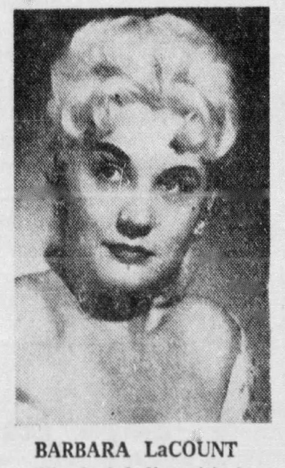
At about 11:00 pm she sat on a bar stool drinking with a customer and another dancer named Siri. At this time Stanley LaCount, Bobbie’s estranged husband, entered the bar and came up behind her. As she turned he drew a .38 caliber pistol from his pocket and shot her once in the back. She gripped the side of the bar for support and gasped “Somebody help me! Siri, he’s killing me.” Then she said “Stan, no Stan!”
Miss LaCount slid to the cigarette-covered floor of the bar and Stan LaCount fired five more times into her body. Stanley LaCount then dropped the now empty pistol, sat on a bar stool, smiled, lit a cigarette and waited for police to arrive. He was arrested by Minneapolis Police and would be charged with 1st degree murder. The Minneapolis Star reported that he was despondent over an impending divorce that his wife had filed, charging that he had often beat her.
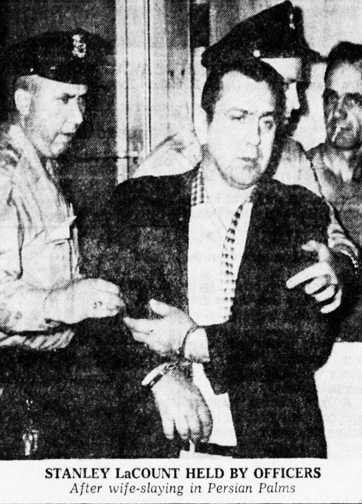
LaCount, a saxophone player who had met his estranged wife playing in strip clubs, gave the reason for the shooting as “because she was the only woman I ever loved and she didn’t want to have anything to do with me.” He plead guilty to 2nd degree murder and was sentenced to life in prison, as he already had an extensive criminal record and was on parole at the time. The wonders of the Minnesota parole system would find him out before 1975 as he married his fourth wife in Robbinsdale that year. LaCount would marry once more before his death in 1982 in Texas from natural causes. Bobbie LaCount was buried in her hometown of Denver.
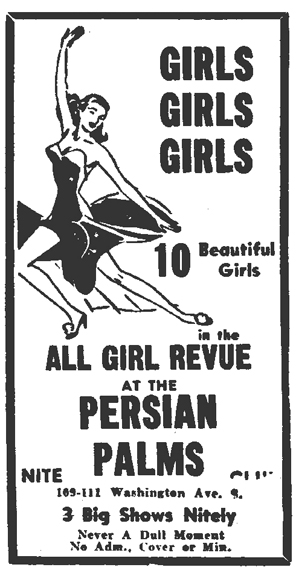
THE MURDER OF HAROLD FULLER
Jack Record had just hit Minneapolis the day of September 2, 1959. By that night he had stabbed Harold E. Fuller to death in front of the Persian Palms and was in jail. “And I’d do it again,” he told Minneapolis police.
Record was a 49-year-old transient with a long police record who had been panhandling on Washington Ave. Fuller was a 28-year-old part time bartender at the Idle Hours tavern in St. Paul, out with his girl June. Fuller had given Record a quarter the first time they met, but when Fuller moved on to another bar, Record insisted that Fuller made a derogatory comment about his race (he was black) and took it in his mind to stab him. June was equally insistent that no words were exchanged.
Fuller, aided by June, staggered into the Persian Palms, and died on the floor. Meanwhile, two bartenders and a customer took off after Record and captured him, surrendering him to the police. Record was tried and sentenced to life in prison.
Pictured below is the deceased Mr. Fuller under the sheet (they published pictures like this in those days), and June in distress next to the policeman.
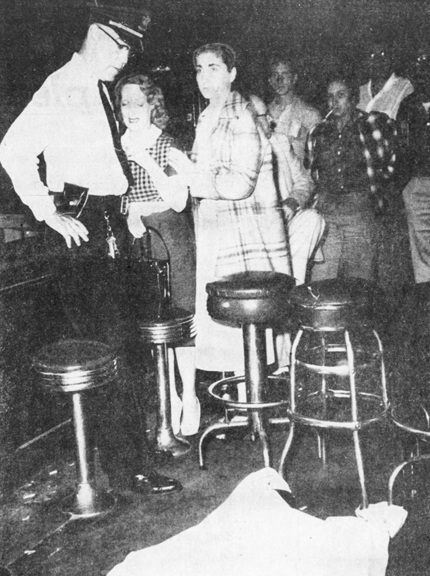
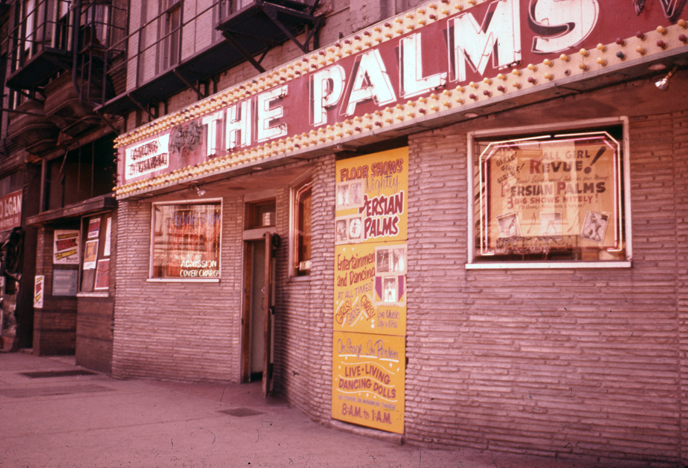
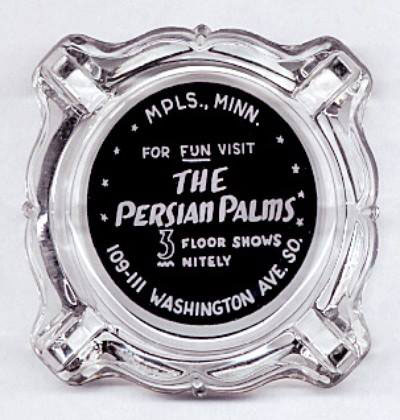
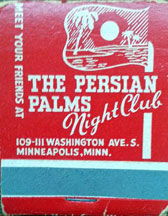
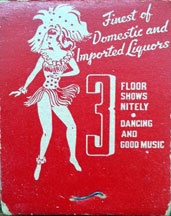
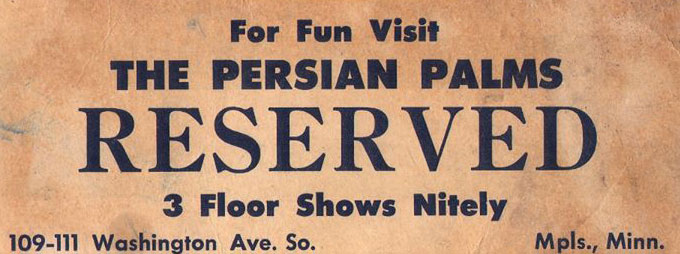
END OF THE PALMS
The last show of 10 Girls 10 was in mid-August 1961, and all fixtures and equipment were sold that same month. The building was demolished in August/September 1961 for the Gateway urban renewal project.
The building was first replaced by the International Business Machine Corp. building in 1963. This was a six-story building that had the address 245-299 Marquette Ave. It was one of the first replacement buildings to be erected in the Gateway Project.
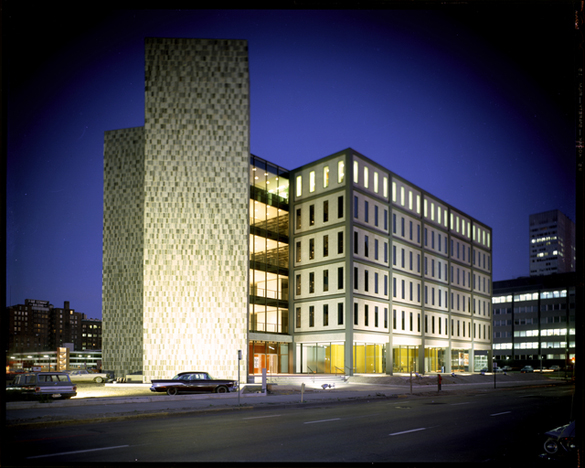
The IBM Building was also one of the first Gateway replacement properties to be demolished – it was removed in 1985 for the ING Reliastar 111 Building, which reverted back to the address 111 Washington Ave. So.
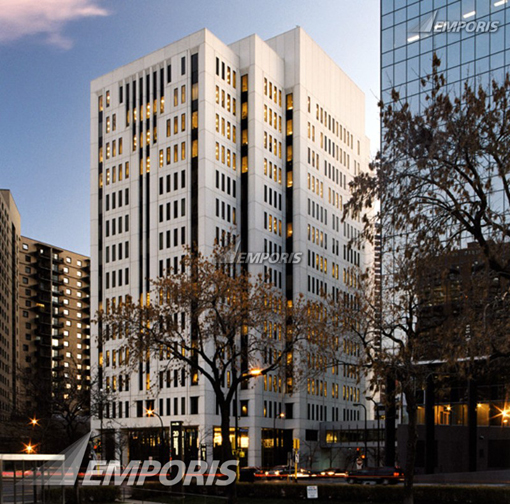
HARRY SMULL AGAIN
In 1959 the Minnesota legislature made it unlawful for one person to have an interest in more than one liquor establishment in Minneapolis, but did not prohibit relatives from holding licenses. In June 1961, Smull and several others were indicted for having interests in more than one liquor licenses – in Smull’s case, seven, including the Persian Palms. In September 1961 the indictments were struck down on the basis that they were unconstitutional. (Minneapolis Tribune, November 12, 1961)
In 1963, when Smull expressed an interest in transferring the liquor license to a new place at 413 Hennepin, he was met with opposition; Alderman Robert MacGregor called the Palms “one of the raunchiest operations in town.” USA Confidential included it in a list of places that “cater to the lowest winos and blowsiest hags.” Smull was eventually approved to open the new place, the Copper Squirrel, in August 1963.
Harry Smull died in April 1972.


